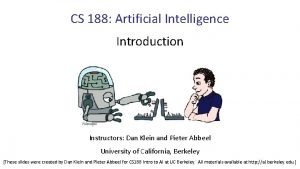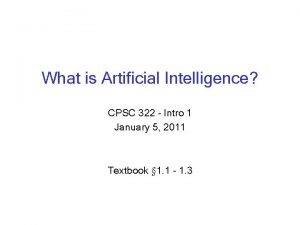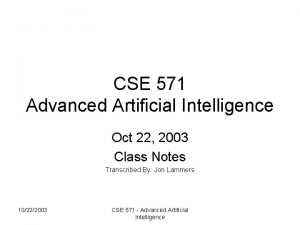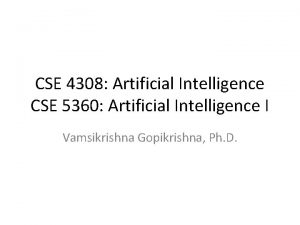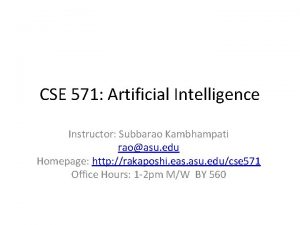CSE 571 Advanced Artificial Intelligence Nov 24 2003








- Slides: 8

CSE 571 Advanced Artificial Intelligence Nov 24, 2003 Class Notes Transcribed By: Jon Lammers 10/22/2003 CSE 571 - Advanced Artificial Intelligence

Learning Structured Models • Definition – Observational Equivalence – – Two structures are observationally equivalent if the set of data can satisfy both graphs by finding a parameters. Operationally Equivalent 10/22/2003 CSE 571 - Advanced Artificial Intelligence 2

Example – Consistency • a is independent of b. • d is independent of {a, b} given c. a b c d Consistent/Minimal 10/22/2003 a P(a/b) = P(a) P(d/a, b, c) = P(d/c) * b a c * b c d d Not Consistent CSE 571 - Advanced Artificial Intelligence Consistent/Minimal 3

Example – Coins A B C P(fair) P(-fair) 0 0 1 . 25 . 28 0 1 0 . 25 . 12 1 0 0 . 25 . 42 1 1 1 . 25 . 18 With fair coins, multiple structures can be derived from the data. Including those that do not correctly capture the causal relationship. Making the coins unfair, leaves you with the correct structure. Fair: P(A) = 0. 50 P(B) = 0. 50 -Fair: P(A) = 0. 60 P(B) = 0. 30 10/22/2003 Correct Structure Only consistent with fair coins. CSE 571 - Advanced Artificial Intelligence a b c a a c b 4

Definition • Stability – Let I(P) denote the set of all conditional independence relationships embodied in P. A causal model M=(D, ΘD) generates a stable distribution if and only if P((D, ΘD)) contains no extraneous independencies - that is, if and only if I(P((D, ΘD))) I(P((D, Θ’D))) for any set of parameters Θ’D. 10/22/2003 CSE 571 - Advanced Artificial Intelligence 5

Algorithm • If you have a large number of nodes, you can have a huge number of possible graphs. • The algorithm generates a graph (non-directed) that is a summary of all the minimal stable structures consistent with the data. • You can arbitrarily put arrows as long as you do not introduce any new “v-structures”. V-Structure 10/22/2003 Not V-Structure CSE 571 - Advanced Artificial Intelligence Not V-Structure 6

Inductive Causation Algorithm 1. For a, b find Sab such that a independent b/Sab, construct undirected graph with edge between a, b if you can’t find Sab. (not Sab = Ø) For each pair of non-adjacent variables a, b with a common neighbor c. If c is not an element of Sab add arrowheads pointing to c from a and b. Orient as many undirected edges as possible while: 2. 3. – – 10/22/2003 Not creating v-structures Not creating directed cycles. CSE 571 - Advanced Artificial Intelligence 7

Rules for Orienting Arrows (Step 3) 1. 2. 3. 4. Orient b – c as b -> c when a -> b and a, c are nonadjacent. Orient a – b as a -> b when a -> c -> b. Orient a – b as a -> b when a – c -> b and a – d -> b and b, c are non-adjacent. Orient a – b as a -> b when a – c -> d and c -> d -> b and c, b are non-adjacent. 10/22/2003 CSE 571 - Advanced Artificial Intelligence 8


